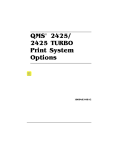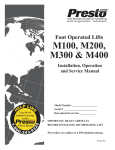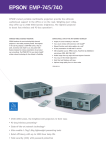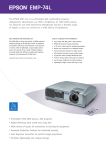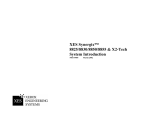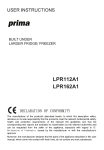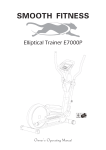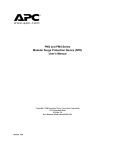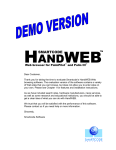Download Xerox 701P98048 Printer User Manual
Transcript
Stacker 1000 Operator Manual 701P98048 Welcome! Congratulations on acquiring the Stacker 1000. Team looks forward to supporting you and helping you increase your organizational productivity. The integrated features, ease of operation, and reliability of the Stacker 1000 allows you to concentrate on your business and leave the printing and finishing to the Stacker 1000. This user manual provides all the necessary information required for operating and using the Stacker 1000. Your Team support group is available to you for further assistance. Call our experts at the appropriate phone number listed at the right. Printer Serial Number: _________________________________ In order to locate the Printer Serial Number, refer to the printer operator manual. All service calls should be reported under the printer serial number. For information or assistance on your Stacker 1000, call: The following information is needed whenever you call : Local Telephone Number: ______________________________ Customer Account Number: ____________________________ A Customer Support Representative will answer any questions or concerns you may have regarding your Stacker 1000. Stacker Serial Number: _______________________________ In order to purchase other equipment, software, and/or supplies, call: In order to locate the Stacker Serial Number, refer to the section of this operator manual entitled “Technical data.” Local Telephone Number: ______________________________ A Sales Representative will assist you in evaluating your needs for other software applications and/or xerographic equipment which will further increase your productivity. ©1998 by Corporation. All rights reserved. ® ® , The Document Company™, the stylized ™, Stacker 1000 , 8830™, and any identifying product names and numbers herein are trademarks of Corporation. Table of contents Safety notes ....................................................... 1 Printer media information.......................................... 9 Stacker overview ............................................... 3 Stacker capacity ......................................................... 9 Introduction ............................................................... 3 Electrical requirements.............................................. 9 Identifying the stacker parts .................................... 3 Power consumption ................................................. 10 Stacker operation ...................................................... 4 Temperature ............................................................. 10 Switching on the stacker ........................................ 4 Heat dissipation ....................................................... 10 Normal operation.................................................... 4 Audible noise............................................................ 10 Tray extensions ...................................................... 4 Power cord length .................................................... 10 Media storage compartments ................................. 5 Features .................................................................... 10 Print size information ............................................. 5 Stacker serial number location.............................. 10 Problem solving................................................. 6 Jam clearance ........................................................... 6 Clearing media jams ...................................................6 Moving the stacker.................................................... 7 Problem solving ........................................................ 7 Technical data.................................................... 8 Stacker relocation ..................................................... 8 Technical data ........................................................... 8 Space requirements....................................................8 Dimensions .................................................................9 Stacker 1000 Operator Manual Table of contents i ii Stacker 1000 Operator Manual Table of contents Safety notes The Stacker 1000 is designed and tested to meet strict safety requirements. These requirements include safety agency examination and approval and compliance to any established environmental standards. Please read the following instructions carefully before operating the stacker. Note: In order to ensure safe operation of your stacker, refer to the instructions, as needed, which are provided in this operator manual. Follow all the warnings and instructions which are marked on or supplied with the product. Unplug the stacker from the wall outlet before cleaning. Always use materials which are supplied or approved by Xerox. The use of other materials may result in poor performance and could create a hazardous situation. Do not use aerosol cleaners. Never use supplies or cleaning materials for any purposes other than what they were intended. Keep all supplies and materials out of the reach of children. Do not use the stacker near water, wet locations, or outdoors. Stacker 1000 Operator Manual Safety notes This product is equipped with a three-wire, grounding-type plug (in other words, a plug which has a third grounding pin). This product also is equipped with an additional safety device. The plug fits into a grounding-type power outlet only. This is a safety feature. If you are unable to insert the plug into the outlet, contact your electrician in order to avoid the risk of electric shock and have the receptacle replaced. Never use a ground adapter plug to connect the copier to a power source receptacle which lacks a ground connection terminal. This stacker must be operated from the type of power source which is indicated on the marking label. If you are not sure of the type of power available, consult your local power company. If an extension cord is used with this stacker, ensure that the total of the ampere ratings of any products plugged into the extension cord does not exceed the extension cord ampere rating. Also, ensure that the total amperage of all products plugged into the wall outlet does not exceed the outlet protection. Do not install the stacker in a direct sunlit area, in a high humidity or dusty environment, nor in a double-insulated room. 1 2 Do not install the stacker where the floor or base is unstable. The stacker may fall, causing personal injury and/or serious damage to the stacker. Unplug this stacker from the wall outlet and refer the servicing of it to qualified service personnel under the following conditions: Never spill liquid of any kind on the stacker. • • • • • • Do not allow anything to rest on the power cord. Do not locate this stacker where people step on the cord. Never remove any covers or guards that require a tool for removal. There are no operator-serviceable areas within these covers. The power supply cord is the disconnect device for this stacker. Ensure that installation is near the outlet and is easily accessible. Never attempt any function that is not specified in this operator manual or is not directed by an authorized Xerox representative. Stacker 1000 Operator Manual Safety notes when the power cord is damaged or frayed; if liquid is spilled into the product; if the stacker is exposed to rain or water; if the stacker is producing unusual noises or odors; if the stacker falls over or the cabinet is damaged; if the stacker continues to malfunction or not work after the procedures in this operator manual are performed. Stacker overview Introduction The Stacker 1000 is an optional finishing device which may be used with the 8830 printer, the 8830 Digital Document System (DDS), or the Productivity Centre 8233. The illustration below shows the Stacker 1000 with a 8830 printer. Identifying the stacker parts Tray extensions (for longersize prints) The Stacker 1000 stacks a maximum of 1000 prints of various sizes. Print sizes include A (A4) through E (A0). Depending on the print size, prints are stacked either by: • Long edge feed (LEF), also called landscape, or • Short edge feed (SEF), also called portrait. Stacker 1000 Operator Manual Stacker overview Media storage compartment (one on each side of stacker) 3 4 Stacker operation 6ZLWFKLQJRQWKHVWDFNHU The stacker is “switched on” by connecting the power cord to the power outlet. 7UD\H[WHQVLRQV The Stacker 1000 is equipped with tray extensions: Tray extensions There is no power switch. The power cord is the on/off switch. Once the power cord is connected to the power outlet, the stacker motor drive and fan initialize. 1RUPDORSHUDWLRQ As media leaves the printer, the lead edge of the media enters the stacker. A motion sensor in the stacker detects the lead edge of the media and the fan and motor are switched on. The media then is fed into the stacker inclined tray. When the motion sensor detects the trail edge of the media, the fan and motor continue to run until the print is fed into the inclined tray. After the last print output is fed into the stacker tray, the fan and motor switch off. Stacker 1000 Operator Manual Stacker overview These tray extensions are used for E-size (A0) and longer-size prints. 0HGLDVWRUDJHFRPSDUWPHQWV As stated before, the Stacker 1000 is equipped with two storage compartments. They are located on each side of the stacker. 3ULQWVL]HLQIRUPDWLRQ As stated before, the Stacker 1000 stacks a maximum of 1000 prints; these prints may be of various media sizes. Depending on the print size, the stacker can hold the following quantities: • D-size (A1) landscape prints: 750 maximum • E-size (A0) portrait prints: 375 maximum The stacker can actually hold a larger number of prints than is shown above. The above numbers reflect the maximum capacity of the 8830 printer with three rolls of the same type media loaded. Media storage compartment These storage compartments may be used to store media, prints, or other printer supplies, such as toner cartridges. Stacker 1000 Operator Manual Stacker overview 5 6 Problem solving Jam clearance &OHDULQJPHGLDMDPV The stacker does not detect error conditions such as media jams. If a media jam occurs, the motor drive and blower switches off, and the stacker no longer accepts media. This is the only indication that the stacker is no longer functioning. Use the following procedure in order to clear a media jam from the stacker: Media jams may occur as the media is exiting the printer or as the media is entering the stacker. When jams occur, the stacker and printer shut down, and the printer displays an error code. 2. Clear any visible, jammed media from the stacker media path. Media must be cleared from the stacker and the printer, if necessary, before a print job can continue. 1. Move the stacker by pulling the entire stacker outward and away from the printer. If part of the media is located in the printer media path, clear the stacker media path first. Refer to the printer operator manual in order to clear the printer media path. 3. If the media, which is exiting the printer, is still connected to the media roll inside the printer, cut the media between the printer and stacker. Refer to the printer operator manual for more information on how to cut the media. 4. Once the media path is cleared, reposition the stacker against the printer. Ensure that the stacker is positioned correctly. The stacker must be resting against the printer and aligned with the output area of the printer. Stacker 1000 Operator Manual Problem solving Moving the stacker Whenever you are required to move the stacker away from the printer, perform the following steps: 1. Move the stacker by pulling the entire stacker outward and away from the printer. Problem solving Problem The stacker is not functioning. Ensure that the power cord is connected to the power outlet. Disconnect and reconnect the cord to the outlet. If the problem continues, call for service. Prints have stopped feeding into the stacker. Check for a media jam in the stacker and/or the printer, and clear any media jams. If the problem continues, call for service. 2. Reposition the stacker against the printer and ensure that the stacker is positioned correctly: The stacker must be resting against the printer and aligned with the output area of the printer. Stacker 1000 Operator Manual Problem solving Action 7 8 Technical data Stacker relocation The stacker must be moved by authorized personnel only. In order to ensure that the stacker operates reliably after moving it to a new location, consider the following guidelines: • The new location must provide minimum clearances around the stacker. These clearances are shown in the diagram which is located in the Technical data section of this manual. • The flooring must be capable of supporting at least 100 lb. (45.5 kg) for the stacker and an additional 650 lb. (295 kg) for the attached printer. • The new location must be well ventilated and must maintain a consistent room temperature. Extreme temperature or humidity changes can affect the stacker. • Power source receptacles must be properly grounded. Technical data 6SDFHUHTXLUHPHQWV )ORRUVSDFHUHTXLUHPHQWV With printer: 122 inches x 117 inches (3101 mm x 2974 mm) +HLJKWFOHDUDQFH 96 inches (2438 mm) from the floor to the nearest overhead obstruction, within the floor space requirements 0RYHDELOLW\ Once installed, the Stacker 1000 can be moved in order to access the printer media drawers. Stacker 1000 Operator Manual Technical data 'LPHQVLRQV :HLJKW 100 lbs. (45.5 kg) +HLJKW 37.9 inches (963 mm) :LGWK 52.8 inches (1341 mm) 'HSWK 44.6 inches (1133 mm) 3ULQWHUPHGLDLQIRUPDWLRQ 0HGLDW\SH • Bond (20 lb.) • Vellum (20 lb.) • Film (4 mil.) • Tracing (4 mil) 6WDFNHUFDSDFLW\ Maximum of 1000 prints of various sizes Maximum of 750 D-size (A1) prints Maximum of 375 E-size (A0) prints (OHFWULFDOUHTXLUHPHQWV 9ROWDJH 85-264 VAC )UHTXHQF\ 47-440 Hz 6WDQGE\&XUUHQW 0 Amps 5XQQLQJ&XUUHQW 0.8 Amps (115 VAC) for USA and Canada 0.5 Amps (250 VAC) for EO The stacker is designed to operate either on a 15 A (115 VAC), 60 Hz for the USA and Canada or on a 20 A (240 VAC), 50 Hz for EO, single phase line with a circuit breaker. A standard 15A or 20A, three-prong, grounded receptacle is required. 0HGLDVL]H • Roll Feed - 11 inches to 36 inches (279.4 mm to 914.4 mm) width 3 inches (76.2 mm) core diameter to 6.7 inches (170.2 mm) O.D.) Stacker 1000 Operator Manual Technical data 9 10 3RZHUFRQVXPSWLRQ 6WDQGE\ 5XQQLQJ Less than 50 watts 50 watts (0.80A rms at 115 VAC; 0.50A rms at 230 VAC) 7HPSHUDWXUH 0LQLPXP 0D[LPXP +XPLGLW\ (OHYDWLRQ 60 F (15 C) 80 F (27 C 20% to 80% Relative Humidity Maximum of 7000 feet (2133 m) above seal level +HDWGLVVLSDWLRQ 6WDQGE\ 5XQQLQJ 0 BTU/hr 170 BTU/hr $XGLEOHQRLVH 69 db(A) maximum 3RZHUFRUGOHQJWK 15 feet (4.5 m) Stacker 1000 Operator Manual Technical data )HDWXUHV • Two media storage compartments • Automatic shutoff • Tray extensions • Automatic media detection Stacker serial number location In order to locate the serial number of your stacker, you must first move the stacker away from the printer. The serial number plate is located on the left of the front cover facing the printer. It’s illegal ,QWKH86$ It is against U.S. law to copy any material which is copyrighted without the permission of the copyright owner. However, if the copying falls within the “Fair Use” library reproduction rights of the copyright law, making copies is allowed. Further information on these U.S. provisions may be obtained from the Copyright Office, Library of Congress, Washington, D.C. 20550, or telephone the Copyright Office at (202) 707-9100 and ask for circular 21. Copying other items may be prohibited. If you have any questions seek legal advice. FCC compliance ,QWKH86$ &ODVV$ This equipment has been tested and found to comply with the limits for a Class A digital device, pursuant to Part 15 of the FCC rules. These limits are designed to provide reasonable protection against harmful interference when the equipment is operated in a commercial environment. This equipment generates, uses, and can radiate radio frequency energy, and if not installed and used in accordance with the instruction manual, may cause harmful interference to radio communication. Operation of this equipment in a residential area is likely to cause harmful interference, in which case, the user is required to correct the interference at their own expense. If necessary, the user should consult the dealer or an experienced radio/television technician for additional suggestions. The user may find the following booklet prepared by the Federal Communications Commission helpful: How to Identify and resolve Radio-TV Interference Problems Stock Number: 004-000-00345-4. Conformité EEM au Canada Cet appareil numérique est conforme aux limites d'émission de bruits radioélectriques pour les appareils de classe A stipulées dans le Règlement sur le brouillage radioélectrique du Ministère des Communications du Canada. Prepared by: Multinational Customer and Service Education 780 Salt Road Webster, New York 14580 Copyright© 1998 by Xerox Corporation. Allrights reserved. XEROX and all product names and number names are trademarks of XEROX CORPORATION. Other company trademarks are also acknowledged. Printed in U.S.A. 701P98048 3/98
















